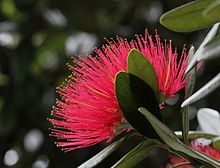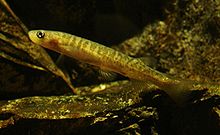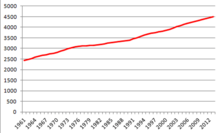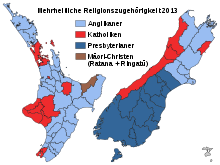New Zealand
![]()
This article is about the state of New Zealand. For other meanings, see New Zealand (disambiguation).
Template:Infobox State/Maintenance/NAME-German
New Zealand (English New Zealand [njuːˈziːlənd], Māori Aotearoa [aɔˈtɛaɾɔa]) is a geographically isolated island nation in the southern Pacific Ocean. It consists of a north island, a south island, and numerous smaller islands. The nearest major landmasses are to the west with the Australian continent (the west coasts of the two main islands of New Zealand are between 1530 km and about 2100 km from the east coasts of Australia and Tasmania), to the north with the French island of New Caledonia and the island states of Tonga and Fiji, and to the south with the continent of Antarctica.
Neither geographically nor culturally can New Zealand be assigned to a specific major region: The country lies partly on the Australian plate and partly on the Pacific plate and is connected both with the European-influenced cultural area of Australia and with the Polynesian part of Oceania. New Zealand is a kingdom in the Commonwealth of Nations with a democratic parliamentary constitution. Unusually for an industrialized country, the main economic sectors are agriculture and forestry, food processing (mainly dairy products), and tourism. New Zealand is known as the "green island", partly due to its sparse population and natural diversity. This, along with the unique vegetation, is also due to the relatively isolated location of the islands.
Flora and fauna
The fauna and flora of New Zealand are among the most extraordinary on earth, as the archipelago has been separated from all other land masses for a very long time and the vegetation was able to develop in isolation. Similar to Australia - where there were also hardly any large carnivores - the farm and domestic animals as well as rats introduced by the European colonialists multiplied invasively and significantly reduced the endemic fauna of the islands as predators and food competitors, so that the original biodiversity is endangered today.
New Zealand has the greatest similarities in the development of flora and fauna with New Caledonia and Lord Howe Island.
Flora
→ Main article: Flora of New Zealand
Around 85% of New Zealand's plant species are endemic. While around 80 % of the country was covered with forests before the arrival of the Māori, native forests still grow on a good 24 % of the country's land area today, of which around 77 % is protected. On about five percent of the country's land area, the New Zealand forestry industry grows fast-growing, non-native tree species such as the Monterey pine (Pinus radiata) and the coast redwood (Sequoia sempervirens).
The country's two main native forest types are, on the one hand, coniferous forests composed of, for example, stonecrops (Podocarpaceae) or kauri trees (Araucariaceae), and deciduous forests consisting mainly of false beech (Nothofagus). Most New Zealand trees are evergreen. The coniferous forests in particular are dominated in appearance by epiphytes such as North Island ironwood (Metrosideros robusta), but a few species related to European mistletoe also live hemiparasitically on southern beech. Numerous ferns, mostly endemic, occur below the dense forest canopy. The most imposing are undoubtedly the tree ferns (Cyatheales), which grow to over ten metres high. The best known of the ferns is the ponga or silver fern, which is New Zealand's national plant. Furthermore, different palm species could develop in New Zealand, as for example the Nikau palm (Rhopalostylis sapida). Finally, the Pohutukawa (Metrosideros excelsa), the South Island Ironwood (Metrosideros umbellata) and the so-called Cabbage Tree (Cordyline australis) are particularly striking.
Approximately ten percent of the state's land area is covered with native open land vegetation. This includes tussock grasslands and scrub and heathland.
Substantial parts of the native vegetation (about one third of the country's area) are protected and this to a large extent in National Parks, Conservation Parks and Forest Parks.
Fauna
Due to its relative isolation, New Zealand has developed a unique ecosystem, the prominent feature of which prior to Polynesian colonisation was the absence of any land mammals, with the exception of three species of bats (the two species of New Zealand bats and Chalinolobus tuberculatus).
Many of the niches that would normally be occupied by mammals have been occupied by birds. Thus, flightless birds play a particularly important role here. They include the kakapo (Strigops habroptilus), the kiwi (Apterygidae), the takahe (Porphyrio mantelli), the weka (Gallirallus australis) and the extinct moa (Dinornithiformes). The birds were hunted by raptors, the largest of which, the shark eagle (Harpagornis moorei), had a wingspan of up to three metres and weighed up to 14 kg. Some of the flightless species are now found only on predator-free islands off the coast of New Zealand. Less of a problem are the powerful parrot species Kea (Nestor notabilis) and Kaka (Nestor meridionalis). In addition, there are numerous birds that fly across the vast expanse of the Pacific to spend parts of the year in New Zealand, such as the Westland Petrel (Procellaria westlandica). Royal albatrosses (Diomedea epomophora) and Australian gannets (Morus serrator) also nest here. Various penguin species such as the thick-billed penguin (Eudyptes pachyrhynchus), the yellow-eyed penguin (Megadyptes antipodes) and the pygmy penguin (Eudyptula minor) share the coasts with New Zealand fur seals (Arctocephalus forsteri), elephant seals (Mirounga leonina) and New Zealand sea lions (Phocarctos hookeri). Finally, dolphins and whales can be found off the coasts.
The Hector's dolphin (Cephalorhynchus hectori) and the Maui dolphin (C. hectori maui) are endangered species. Currently there are 55 Maui dolphins left in the shallow coastal waters of New Zealand's west coast - in the 1970s there were around 1500 animals. Swallows were brought to New Zealand in large numbers from Europe by the Minister of Agriculture in the early 20th century. New Zealand is also home to the Tuatara (Sphenodon punctatus), an ancient reptile species, the New Zealand Primitive Frogs (Leiopelmatidae) and the Wetas (Anostostomatidae), an insect family whose largest representatives can grow up to ten centimetres long. New Zealand is one of the few countries in the world where there are no terrestrial snakes (but there are three species of sea snakes in the surrounding sea). However, almost 60 species of lizards are found in New Zealand, mainly skinks of the genus Oligosoma, the New Zealand brown geckos (Hoplodactylus) and the green geckos (Naultinus).
New Zealand's rivers, streams and lakes are home to only 64 species of freshwater fish of which more than 20 were first introduced by Europeans. Of the freshwater fishes present before the arrival of the Europeans, 22 species belong to the family Galaxiidae, 7 to the family Eleotridae and 3 to the family Retropinnidae.
The arrival first of the Māori and later of the Europeans has led to two spectacular waves of extinction due to human interference with nature and because of intentionally and unintentionally brought animals (neozoa), mainly rats, but also dogs, cats, hedgehogs, stoats and other weasel species as well as the Australian fox cusu. The New Zealand government tries with different measures to save the endemic species, which are threatened in their existence by imported animals, above all the many different birds, from extinction. On the one hand, their reproduction is prevented by castration, for example of cats, and on the other hand, New Zealand is a world leader in the eradication of imported animals and has begun to restore smaller islands off the coast to their pre-colonisation state and to reintroduce native species there, in order to extend the project to the two main islands in the next stage.
In 1907, three pairs of chamois arrived in New Zealand as a gift from the Austrian Emperor at the request of New Zealand Prime Minister Richard Seddon. They were released on the Hooker River near Aoraki/Mount Cook and are said to have settled in and reproduced by 1909.
See also: National Parks in New Zealand
Environmental issues
According to a 2019 report by the Environment and Statistics Authority of New Zealand, the country is exploiting its nature ever more mercilessly. According to the report, agriculture and gradually also tourism are endangering entire ecosystems. Numerous species are threatened with extinction, and humans are encroaching further and further into previously untouched landscapes. The natural paradise is on the verge of collapse. According to the report, rivers and lakes are particularly endangered. 95 percent of all running waters in the lowlands are polluted, and the water quality is so poor that bathing is not allowed in most of them. In every second watercourse, the contamination with bacteria is five times higher than the guidelines of the Ministry of Health.

Treetops of two Kauri trees

Flower of an ironwood tree (Rata)

A Kea in Canterbury

A northern striped kiwi

Galaxias vulgaris , a freshwater fish endemic to New Zealand.
Population
Demographics
At the 2013 census, New Zealand had a population of 4,242,048. Accordingly, 25.2% of the population was not born in New Zealand. About two-thirds of the population increase in the last five years is due to immigration. The population density in 2013 was around 17.5 inhabitants per km² (Germany: 231 per km²). This makes New Zealand one of the most sparsely populated countries in the world, even though it is many times more densely populated than its neighbour Australia (2.6 inhabitants per km²). The population is unevenly distributed among the different parts of the country. While only about one million people live on the larger South Island and large parts of the country - such as Fiordland - are virtually uninhabited, about 1.3 million people live in the metropolitan region of Auckland alone, the country's largest city. In total, more than three million people live on the smaller North Island.
The average age (as of 2016) is 37.8 years. The birth rate is 13.3 per 1000 inhabitants (as of 2016), while there were 7.4 deaths per 1000 people in the same period. Immigration added another 2.2 people per 1000 population to the population. The infant mortality rate was 4.5 per 1000 live births in 2016, while an average of 2.03 children are born per woman (fertility rate). New Zealand was thus one of the youngest countries in the Western world. Life expectancy at birth is 81.2 years (2016). While men live to an average age of 79.1 years, women reach an average age of 83.3 years.
With an urbanization rate of 86.3% in 2016, New Zealand is one of the countries with the highest percentage of urban population in the world. Almost a third (32 %) of the country's total population lives in the city of Auckland alone.
Ethnic composition
New Zealanders of European descent, called Pākehā, make up the majority of the population. This ethnic group is largely from the British Isles, but also from Germany, Italy, Poland, the Netherlands and numerous other European countries. Immigrants from Bohemia from 1860 to 1876, who settled in Puhoi, Ohaupo, and Te Rore on the North Island, constitute a special German-speaking group. Overall, New Zealanders of European descent make up about 67.6% of the total population. The second largest population group is made up of New Zealand's Polynesian-descended indigenous inhabitants, the Māori, who make up 14.6% of the population. Between 1996 and 2006, Asians rose to become the third largest ethnic group with a total of 9.6%. The Chinese are the largest group at 2.8%, ahead of Indians at 1.7%. By 2001, the Asian population group had overtaken people from the Pacific Islands, who made up about 6.9% of the country's population in 2006. Most of the Pacific Islanders are from Samoa, followed by the Cook Islands as well as Tonga. In 2017, 22.7% of the population were migrants. The most common countries of origin were the United Kingdom (270,000 people), the People's Republic of China (100,000), India and Australia (70,000 each). Approximately 10,000 German-born persons live in New Zealand.
(As of the 2006 census, note that in New Zealand it is possible for a person to belong to more than one ethnic group, and in 2006 for the first time people were offered the option of not belonging to any particular ethnic group, which 11.1% took advantage of. )
Religion
New Zealand has a comparatively large non-denominational population. In the 2013 census, 55% of the total population professed (at least) one religion - including 48.9% Christians - while 42% said they did not belong to any religion. The most common Christian denominations are Roman Catholic (12.6%), Anglican (11.8%) and Presbyterian (8.5%); a further 5.5% described themselves as Christians without specifying a particular denomination. The Ringatū Church and the Ratana Movement, which were founded by Māori, can also be counted as Christianity (1.4%). Other notable religions represented are Hinduism (2.3%), Buddhism (1.5%) and Islam (1.2%).
While both the Anglican and Presbyterian churches have suffered from membership decline in recent years (falling by 21% and 23% respectively between 2001 and 2013), most other religious denominations have seen membership growth, mostly through immigrants. The Catholic Church is already the largest denomination in the major cities of the North Island. Hindu and Muslim numbers have roughly doubled between 2001 and 2013.
Due to the pronounced proportion of Presbyterians in the south of the South Island, one can still see today that this area was settled primarily by Scottish immigrants. The Catholic majority in some rural districts, for example in Waitakere City, is due to immigration of Croats from the Kingdom of Dalmatia. The Italian Catholic community is the largest group among New Zealand Catholics due to very high immigration.
Languages
New Zealand has two official languages: Te Reo Māori and New Zealand Sign Language. English is not an official language, but is only referred to as a de facto official language, despite the fact that English is spoken by around 96% of the New Zealand population. English is also the language used by official bodies since the beginning of New Zealand's colonisation and used in administration and legislative texts. In August 2015, a citizen of the country started a petition with the aim of introducing English as an official language in New Zealand. The outcome is still open.
While both Māori and New Zealand Sign Language are understood or even actively used by a relatively small proportion of the population, New Zealand English is the main vernacular. This variety of English is related to Australian English, but differs from it in the fundamentally different stress on some vowels and words, so misunderstandings between speakers of New Zealand and Australian English are not impossible. Other special features of New Zealand English are words borrowed from the Māori language. Their use is particularly common among the Māori population.
Māori (proper name: Te Reo Māori) lost more and more importance until the 1970s, and the number of Māori speakers decreased continuously. On 1 August 1987, however, Māori became an official language, and since then more and more schools - both public and private - have taught Māori as an elective subject, giving New Zealanders of European descent access to the language. Since then, the number of those who speak and understand Māori has been on the rise again, especially in the 3- to 25-year-old age group. Overall, 4.2% of the population was reported to be able to speak Māori in 2006. New Zealand Sign Language (NZSL) also became an official language on 10 April 2006, making it the world's first language for the deaf to have this status. Although it has been taught in special schools since 1994 and the first dictionary for the language was published in 1998, the number of people who knew sign language was just 0.6% in 2006. The number of deaf or hearing-impaired people in New Zealand is about twice that.
In addition to the three official languages, numerous other languages are spoken in New Zealand, brought to the country by the many immigrants, these included in 2013 the six most widely spoken languages, such as English (96.1%), Māori (3.7%), Samoan (2.2%), Hindi (1.7%), Chinese spoken in the north of China including Mandarin (1.3%) and French (1.2%). German is only spoken in significant numbers in the Wellington (fifth most) and Canterbury (fourth most) regions.
There is no compulsory teaching of foreign languages in New Zealand, they are taught on demand. Since 2015, the most popular foreign languages are Chinese, followed by French, which was previously the most common foreign language learned in New Zealand.
Personalities with a German connection
German speaking personalities in New Zealand
The development of New Zealand has always been decisively shaped by German speakers and people of German origin. Already in the course of the settlement of New Zealand by Europeans, numerous Germans, Austrians and Swiss reached the other end of the world. The emigrants were recruited by the New Zealand Company mainly in Northern Germany. During the 19th century, people of German descent formed the second largest ethnic group to immigrate to the Pacific nation after the British. They settled first in the region around Russell in the north of New Zealand, on the Banks Peninsula ("German Bay") in the southeast of the country, and later also near Nelson in the centre of the state. Many place names still bear witness to the time of early German immigration to New Zealand, e.g. "Neudorf", a world-renowned winery northwest of Nelson.
Persons of German-speaking origin include:
- Ernst Dieffenbach (1811-1855), first European climber of Mount Taranaki
- Julius von Haast (1822-1887), mineralogist and geologist, mapped large parts of the country as a government geologist; in 1865 named the Franz Joseph Glacier after the then Austrian Emperor Franz Joseph I. The Haast Pass, the southernmost crossing of the Southern Alps, is named after him, as are the Haast Eagle and the town of Haast (New Zealand).
- Benedix Hallenstein (1835-1905), merchant, manufacturer and politician of German descent.
- Ferdinand von Hochstetter (1829-1884), geologist and naturalist, produced the first geological map of the country; a species of New Zealand frog, Leiopelma hochstetteri, and Hochstetter Peak were named after him.
- Friedensreich Hundertwasser (1928-2000), spent the last years of his life in Northland, in Kawakawa there is a public toilet facility in the Hundertwasser style.
- Gottfried Lindauer (1839-1926), Austrian-born painter
- Karl Popper, Austrian-British philosopher (in New Zealand 1937-1945)
- Herbert Otto Roth (1917-1994), Austrian-born socialist, historian, and librarian at the University of Auckland.
- Gustav von Tempsky (1828-1868), former Prussian officer; British major of the "Forest Rangers" and one of the most ruthless persecutors of the Māori
- Karl Wolfskehl (1869-1948), poet of German origin
- Georg Wilhelm von Zedlitz (1871-1949), first professor of modern languages at Victoria University of Wellington; today a building there is named after him.
Personalities of German descent
- David Lange (1942-2005), former Prime Minister (1984-1989)
- Arnold Nordmeyer (1901-1989), pastor, politician, minister, and leader of the New Zealand Labour Party.

Population development 1961-2013 (× 1000)

New Zealand's largest denominations per district (2013)

Population pyramid of New Zealand 2016
Questions and Answers
Q: What is the name of the country in Māori language?
A: The name of the country in Māori language is Aotearoa.
Q: Where is New Zealand located?
A: New Zealand is located in Oceania, to the southeast of Australia, in the south-western part of the Pacific Ocean.
Q: How many islands does New Zealand consist of?
A: New Zealand consists of two large islands (the North Island and South Island) and many smaller islands.
Q: What are the official languages spoken in New Zealand?
A: The official languages spoken in New Zealand are English, Māori and New Zealand sign language. English has never been granted official language status in NZ laws, but it is used as a default official language due to its wide usage.
Q: What are the capital city and largest city on North Island?
A: The capital city on North Island is Wellington and the largest city is Auckland.
Q: What is the largest city on South Island?
A: The largest city on South Island is Christchurch.
Q: In 2010, what was reported about happiness level in NZ?
A:In 2010, a newspaper reported that New Zealand was 8th happiest country in the world.
Search within the encyclopedia